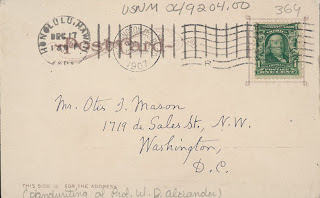The National Anthropological Archives holds a plethora of picture postcards in its collection. These postcards depict scenes from the Americas as well as around the world. One region well-represented in early postcards at the National Anthropological Archives is Hawaii.
Did you know that it was not until May 19, 1898, following public outcry, that the US Congress passed the Private Mailing Card Act finally allowing privately published and printed picture postcards to be mailed at the same rate as the one-cent, pre-stamped government printed postal cards? Picture postcards were first popularized in the United States as souvenirs sold at the World Columbian Exposition in Chicago in 1893, however at that time to actually send a picture postcard still cost the full-letter postage rate of two cents.
Since 1872 the United States Postal Service held a monopoly on the printing of postal cards. One side of the pre-stamped governmental postal card was only to be used for the address, while the reverse side was for writing or drawing. The Private Mailing Card Act, however, prompted the beginning of the mass production of picture postcards. Initially, these privately created postcards were asked to adhere to the same standards as government postcards. Over time, however, restrictions eased allowing postcards to become a highly successful means of sending short messages. Particularly important for the development of picture postcards, in 1907, for the first time, senders were permitted to write messages on the address side of postcards, which allowed for the entire front of the post cards to be used for design. The postcards were divided so that the address could be written on the right side and a message written on the left side. The left side typically included a description of the image on the front of the postcard.
Click here for a Chronology of the Picture Postcard from the Smithsonian Archives.
After the turn of the century and until World War I postcards were ubiquitous in towns and cities across America – sold, mailed and collected in albums. Sometimes stereotyped in the images they presented, postcards portrayed people and places in America, as well as life in other countries and cultures. In 1908 it is estimated that nearly 700 million postcards were mailed, when the entire U.S. population was only 89 million. More and more postcard companies entered the market – anticipating economic benefit. With the development of new printing technologies, the widespread use of photography, and improvements in U.S. postal delivery, postcards became an inexpensive and easy way for Americans to send short messages to one another. They also became a primary means to distribute photographic images to the masses.
Click here or more on the Golden Age of Picture Postcards.
Posted by Whitney Hopkins, Volunteer

















This was an informative blog about the history of postcards. It made me want to get out my collection to review.
ReplyDelete